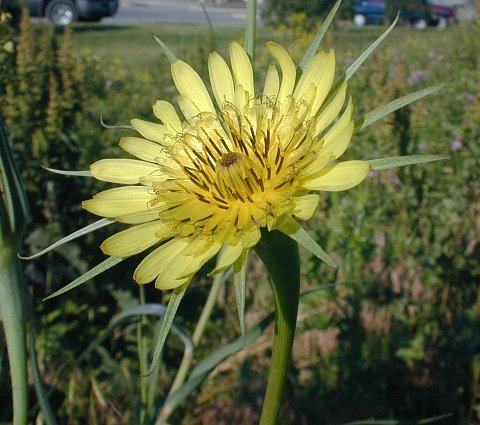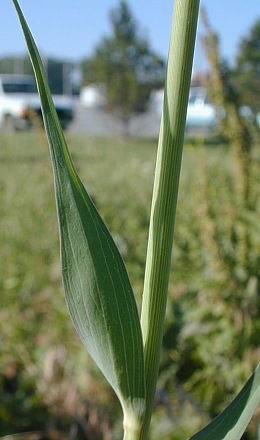Description: This herbaceous plant is usually a biennial that consists of a rosette of basal leaves during the 1st year. During the 2nd year, it sends up one or more flowering stalks about 1-3' tall that are little branched. The round stems are glabrous, often becoming somewhat enlarged at the base of the cauline leaves. These alternate leaves are up to 1' long and ¾" across, becoming smaller as they ascend the stems. They are linear-lanceolate, glabrous, and smooth along the margins. Each leaf has parallel venation and strongly clasps the stem at its base. The basal leaves are similar in appearance to the cauline leaves. Both the stems and leaves are pale greyish green or bluish green, and they contain a white milky latex. The upper stems terminate in long naked flowering stalks, each stalk producing a single flowerhead. The flowering stalk becomes enlarged underneath the flowerhead.

Each flowerhead is
about 2" across, consisting of numerous ray florets that are pale
yellow and about 13 linear-lanceolate floral bracts that are about the
same color as the stems and leaves. These floral bracts extend beyond
the outer margin of the flowerhead as defined by the ray florets. The
outer ray florets are substantially longer than the inner ray florets.
Each ray floret has an outer tip with 5 small teeth; it is either
truncated or rounded. At the base of each ray floret, there is a
columnar reproductive structure consisting of a style that is divided
at its tip and several black anthers that are appressed together around
the middle of the style. The blooming period occurs from late spring to
mid-summer and lasts about 1–1½ months. The flowerheads open during the
early morning, but become closed by the afternoon. Each ray floret is
replaced by a linear achene that has a thread-like beak, to which is
attached a tuft of hairs. These hairs are slightly branched and
plumose. They are usually white toward the base, but become tawny brown
toward their tips. Collectively, these tufts of hair form a spherical
ball about 3" across. Distribution of the achenes is by the wind. The
root system consists of a fleshy taproot. This plant spreads by
reseeding itself.
Cultivation:
The
preference is full sun, mesic to dry conditions, and poor soil that
contains sand, clay, or gravel. This plant will also grow in fertile
loam, where it will become taller.
Range & Habitat:
Western Goat's Beard is a common plant in most areas of Illinois,
except the SW, where it is occasional or absent (see Distribution
Map). This plant is adventive from Eurasia, and it is now
common in the northern Great Plains and many areas of midwestern United
States. Habitats include areas along railroads and roadsides,
dry weedy meadows, vacant lots, pastures, and waste areas. This plant
prefers disturbed areas.
Faunal Associations:
The nectar and pollen of the flowerheads attract various bees and
flies. Because the milky white latex of the foliage is bitter, this
plant is usually avoided by livestock and other mammalian herbivores.
Photographic Location:
Along a railroad in Urbana, Illinois. The photograph of the flowerhead
shows part of a large flower bud on the left.
Comments:
Western Goat's Beard appears to prefer drier habitats than other Tragopogon
spp. (Goat's Beards) in Illinois. While Tragopogon
pratensis (Yellow Goat's Beard) is often found in grassy
areas along roadside ditches, Western Goat's Beard typically occurs
along railroads in dry gravelly areas. These two species have a very
similar appearance and can be difficult to tell apart. However, Yellow
Goat's Beard has floral bracts that are shorter and fewer in number
(there are about 8 bracts that extend to the outer margin of the ray
florets, but usually not beyond), and its foliage tends to be less pale
than the foliage of Western Goat's Beard. The other species in this
genus, Tragopogon porrifolius (The Oyster Plant),
is sometimes cultivated as a root vegetable in gardens, from where it
occasionally escapes. However, the flowerheads of the Oyster Plant are
purple, rather than yellow. Another common name for Tragopogon
dubius is Sand Goat's Beard.